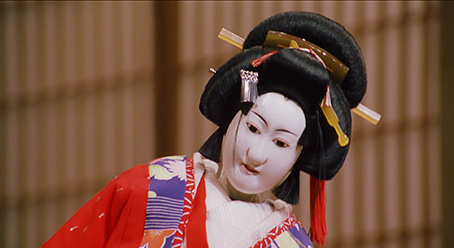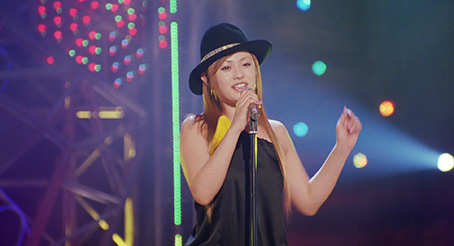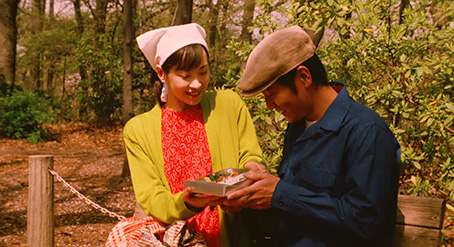|
Note: The review of the film has been updated from my review of the 2003 Artificial Eye DVD.
The second shot of Kitano Takeshi's 2002 return to home turf after his US co-production Brother consists of a semi-circular camera move that rotates around two Japanese Bunraku puppets (a popular theatre form in Japan, but far less well known in the West than Kabuki or Noh), which are motionless and lacking emotional expression. This shot is repeated early on in the first of the three stories told here, though this time the subjects are human in form, a girl in a state of post-overdose shock sitting next to her ex-fiancée, who is stunned into near catatonia at what has become of the woman that he loved. Quietly establishing the link between the puppets and their human counterparts, Kitano's message becomes increasingly clear, that like the dolls in his intriguing opening sequence – which shows the Bunraku puppeteers skilfully operating their characters as a lone narrator pleads and weeps and sings us through the Chikamatsu play they are performing – people can be also manipulated and controlled, not just by others, but by their own emotions and beliefs.
Dolls tells three stories of obsessive love, loss and sacrifice. Central to the first is Matsumoto, who despite having pledged to wed his long-time sweetheart Sawako, has been persuaded by his parents to marry for position and personal advancement instead. On the day of Matsumoto's wedding, a heartbroken Sawako tries to take her own life, an act that transforms her into an emotionless, unfeeling shell of her former self. Matsumoto flees his wedding ceremony and takes Sawako away with him, and the two become bonded in more than just the emotional sense, wandering the land joined together by a length of red rope that sees them labelled as The Bound Beggars. In the second story, yakuza boss Hiro is prompted by his new bodyguard's philosophy on relationships to recall a woman he once loved but left behind in order to seek his fortune. She pledged to wait for him and he promised to return but never did, and now as an old man he looks back with regret on the chance for happiness that he may have passed by. In the final tale, road worker Nukui idolises pretty young pop star Haruna, but is jealous of his rival Aoki, whom Haruna seems to be more aware of. When the star is injured in an automobile accident, she withdraws from society and refuses to see anyone, and Nukui plans extreme measures in order to meet the object of his devotion.

Coming from director Kitano Takeshi, and especially following his violent, cross-cultural gangster film Brother, Dolls proved to be something of a surprise. Although there have been very notable exceptions – A Scene at the Sea and Kikujiro come readily to mind – many of his early signature films reminded me of writer Mishima Yukio's description of art as the unification of the pen and the sword, "poetry with a splash of blood." Several of Kitano's early tales of moral outsiders boast a poetic approach to storytelling and character that can be disrupted by jarring bursts of violence, an artistic reflection of the duality of Japanese culture, in which its own turbulent history and famed warrior spirit seems almost at odds with elegant beauty of its art in all of its guises. And despite their famed explosions of violence, each of these films has a strong emotional core that really registers – the heart-rending wallop delivered by the final scene in Hana-Bi is one that leaves me reeling on every viewing.
On the surface, at least, Dolls appears to be a very different beast, a formal exercise in style that pushes the violence off screen and takes an almost observational approach to storytelling. Emotional and character depth are in short supply, and like the Bunraku puppets of the opening scene, several of the key characters move through the narrative with seemingly little or no expression. This, it turns out, is a carefully calculated decision, and one that against all odds proves quietly compelling. Sawako's suicide attempt has left both her and Matsumoto emotionally damaged, and it is to Kitano's credit that he makes their virtually wordless transformation to the wandering Bound Beggars such a fascinating one, despite the seemingly aimless nature of their travels. Their story registers in the smallest of moments, and late in the tale, when a flicker of emotion is allowed to break their stoic surface, it is Sawako's grief at a broken toy and her fractured attempt at a smile – one lost in a sea of painful memories – that moves us, rather than Mutsumoto's anguished and regretful hug.

The second story takes more traditional approach to character development, and works primarily through seasoned actor Mihashi Tatsuya's finely judged portrayal of yakuza boss Hiro and the entrancing manner in which his story unfolds. More familiar narrative buttons are certainly pushed here, but Kitano still delivers a story twist that toys with expectations and ultimately prevents the characters from finding what they have been looking for. Though Hiro is careful with his words, it is his face that betrays the regret and sadness that have become his closest companions.
The final story is the most recognisably Kitano authored tale, with Haruna's car crash and facial disfigurement unavoidably recalling the director's own fateful scooter accident some years earlier. It's also here that the lion's share of the film's few comic moments appear, whether it be Nukui dancing around in his bedroom miming to Haruna's electro-pop song (made all the funnier by his own grunts and body movements being as loud as the muted music filtering through the headphones), or the head-smacks delivered by his seemingly idle supervisor as a reprimand.
The stories are not separated by intertitles and the switch from one tale to another is triggered by nothing more than a straightforward cut to a previously unseen character and location. In common with some other modern films built around the three story format, characters in each tale here do occasionally intersect with others, but the connection is always slight – Hiro's long lost love turns out to be Nukui's neighbour, while Matsumoto and Sawako pass both Hiro's front door and the beach on which Nukui and Haruna will later meet. The inference is that far from being unusual, there could be such stories behind almost any door. The film's lightest moments, meanwhile, are supplied by two minor characters, a disabled boy and his friend who drift cheerily in and out of all three narratives, commenting on the oddness of the bound beggars and then failing to catch fish because they have used tangerine for bait.

At times visually striking – the four seasons are vividly captured through some beautiful location work, cinematography and costume design – many of Kitano's trademarks are clearly visible, particularly in the editing (Kitano is his own editor), with key events rarely seen and shown instead only in aftermath, which is often presented as a single static shot that can be as jarring as the action that it creatively bypassed. This is most effective in the film's later stages, but mid-way allows Kitano to kick against expectations and reveal the results of a gang shoot-out without showing any on-screen gunplay. Building on the non-linear cutting from the first act of Hana-Bi, the opening ten minutes of Matsumoto and Sawako's story at times reminded me of early Nicolas Roeg, the broken-mirror presentation of Sawako's suicide attempt reflecting the chaotic emotional state of a character soon to be drained of all feeling.
On its UK release, Dolls was praised for its visual beauty but criticised for being emotionally hollow, but I think that misses the point and misreads the film. It is right that these characters should appear to be devoid of feeling – culturally, narratively and their nature as puppets of obsession makes this feel so appropriate – but to equate a lack of emotional expression by the characters with a lack of feeling in the film itself is wrong. A painting, a musical number, even nature itself can all provoke strong emotional responses, and film as an artistic and storytelling medium is no different, and despite the careful calculation of surface structure, this is a touching and ultimately affecting work. Kitano's restrained direction and minimalist editing, coupled with Yanagishima Katsumi's gorgeous cinematography, Yamamoto Yohi's costumes, a typically evocative Joe Hisaishi score and, yes, some cannily judged low key performances, makes this a fascinating, involving and creatively exciting film that ultimately speaks to the heart as well as the intellect.
The most recent film in the trio of Kitano Takeshi titles released on Blu-ray by Third Window over the past couple of months, Dolls also sports the most striking transfer. The film really does look delicious here, with a pin-sharp rendering of picture detail matched by absolutely spot-on contrast. The colour rendition is utterly gorgeous throughout, from the eye-catching and colour-themed hues of Yamamoto Yohi's costumes and Isoda Norihiro's production design to the richly rendered reds of the autumnal leaves and the golden tones of the second story flashbacks. Free of any dust or damage, the transfer here is just lovely in every respect.

The DTS 5.1 Japanese soundtrack (and as far as I can ascertain, it is DTS rather than the expected DTS-HD) is also in superb shape, with crystal clear dialogue and a full-blooded reproduction of Joe Hisaishi's emotive score. The surrounds are also put to subtle but effective use, largely for the music and location atmospherics, but it fires on all cylinders during Haruna's studio performance of one of her pop hits.
There's a footnote here to the effect that the image quality on some of the extras here is at the mercy of their source material and thus not up to Third Window's preferred standards. The interviews have all been ported over from Artificial Eye's 2003 DVD release and still look good, despite being SD.
Interview with director Kitano Takeshi Pt. 1 (15:04)
In my original review of Artificial Eye's DVD I for some reason suggested that this interview with director Kitano was not that informative, but watching it again I can't help wondering what the hell I was thinking. Recorded, I'm guessing, shortly after the film's completion and framed 4:3, it's peppered with interesting responses to textual questions, including the origins of the project, information on the Bunraku play that opens the film and how it relates to the human stories, the film's striking use of seasonal colour, how the costumes of Yamamoto Yohi impacted on the film's style, and more. I was also intrigued to learn that Kitano's late grandmother was a recognised Gidayu, a narrator for Bunraku plays.
Interview with director Kitano Takeshi Pt. 2 (14:25)
Despite a couple of frivolous questions ("Is a woman more beautiful when she laughs or cries?"), this is another engaging chat with Kitano in which he talks about the origins of the Bound Beggars story, how people are connected by invisible threads, how being an observer in his youth fed his later comedy material, and the possibility of reading the stories in metaphysical terms. Not all of the textual questions relate directly to the film, with Kitano recalling his childhood memories of local yakuza, who were almost heroes to kids like him, and he intriguingly suggests that making films is his struggle to understand death. This interview was clearly conducted at a later date to its predecessor, indicated by the 16:9 framing and Kitano's signature post-Zatoichi white hair.

Interview with Costume Designer Yamamoto Yohji (10:01)
The film's affable and talented costume designer talks in clear English about his approach to the film, his reaction to the idea of using bunraku dolls as a central thread, his inspiration for the costumes, the concept of "unusual love" and more. Particularly engaging is the revelation that when Kitano wants to communicate something important he doesn't tell him about it but instead gives him an object as a hint or guide.
Interview with Star Kanno Miho (3:55)
A too-brief interview with actress Kanno Miho, who plays Sawako in the Bound Beggars story and talks about working with Kitano and her approach to playing such an emotionless role.
Interview with Nishijima Hidetoshi (3:39)
A similarly brief but enjoyable interview with actor Nishijima Hidetoshi, who plays Matsumoto in the Bound Beggars story. He was clearly in awe of Kitano from the off and talks cheerfully about his approach to the role (he has the red chord that bound Matsumoto and Sawako in his hands the whole way through) and Kitano's minimalist approach to directorial communication.
Scenes From the Shoot Footage (18:04)
A welcome if typically rag-tag scattering of behind-the-scenes footage, with emphasis on the shooting of the Bound Beggars story. It may be a review disc thing, but there appear to be no English subtitles on this extra, though the conversations that are overhead are brief.
Venice Film Festival 2002 (8:02)
An engaging collection of grabbed DV footage of Kitano and his lead actors at the Venice Film Festival, where the film was nominated for the Golden Lion but lost out to Peter Mullan's The Magdelene Sisters.
Original Japanese Trailer (1:42)
A wordless trailer for a damned tricky sell, even on home turf and to those familiar with the director's previous work. The image quality isn't at all bad, but does serve to illustrate how ravishing the transfer of the main feature is by comparison.
I said before that the audience for Dolls is likely a specialist one, yet when we arranged a local cinema screening it pulled in a respectable sized audience, including a fair few who were new to this distinctive filmmaker's work. Its slow pace, emotionally drained characters and downbeat tone are going to prove a barrier for some viewers, but for the patient, adventurous audience, Dolls is a bold and enthralling experiment in style and image-driven storytelling. It's a compelling, visually strikingly and arrestingly individualistic work that, sandwiched as it is between the more commercially minded Brother and Zatoichi, remains an artistically fascinating film from one of modern cinema's most uniquely talented directors.
The transfer on Third Window's Blu-ray is an absolute treat, and the extra features supplement the film well. I can't fault this release. Highly recommended.
The Japanese convention of surname first has been used for Japanese names throughout this review |